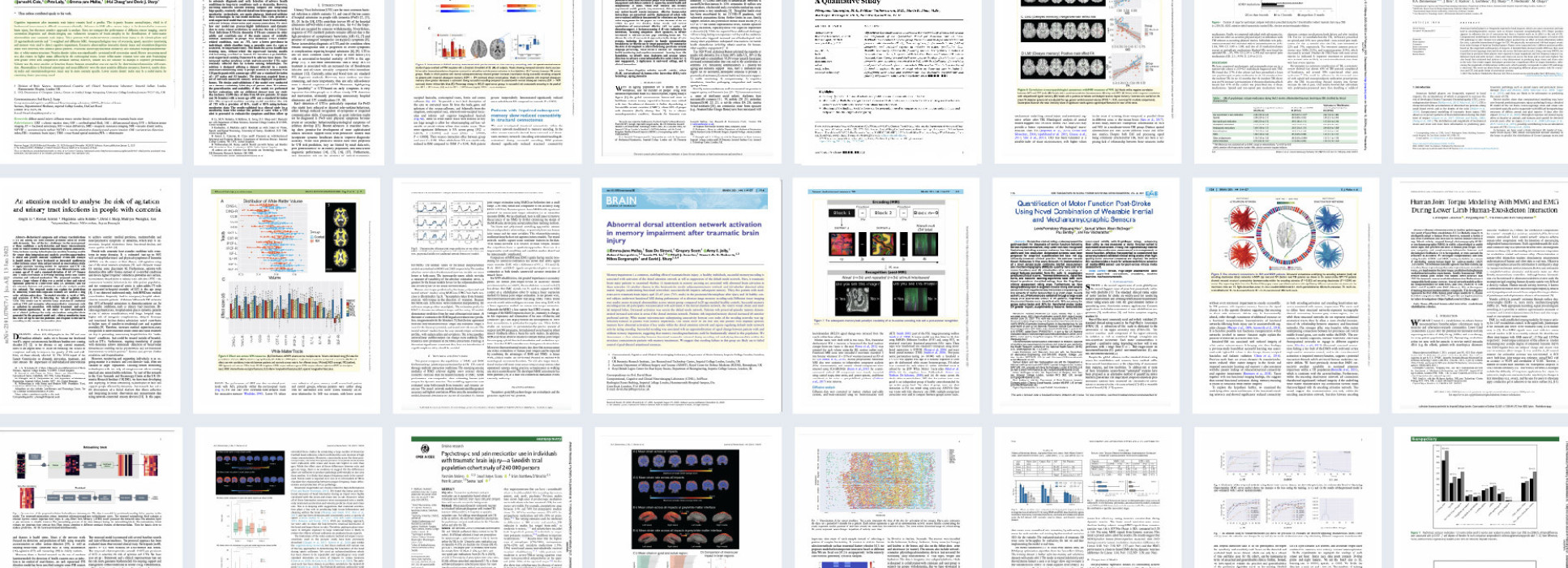
Results
- Showing results for:
- Reset all filters
Search results
-
Journal articleHadjipanayi C, Yin M, Bannon A, et al., 2024,
Remote gait analysis using ultra-wideband radar technology based on joint range-Doppler-time representation
, IEEE Transactions on Biomedical Engineering, Vol: 71, Pages: 2854-2865, ISSN: 0018-9294Objective: In recent years, radar technology has been extensively utilized in contactless human behavior monitoring systems. The unique capabilities of ultra-wideband (UWB) radars compared to conventional radar technologies, due to time-of-flight measurements, present new untapped opportunities for in-depth monitoring of human movement during overground locomotion. This study aims to investigate the deployability of UWB radars in accurately capturing the gait patterns of healthy individuals with no known walking impairments.Methods: A novel algorithm was developed that can extract ten clinical spatiotemporal gait features using the Doppler information captured from three monostatic UWB radar sensors during a 6-meter walking task. Key gait events are detected from lower-extremity movements based on the joint range-Doppler-time representation of recorded radar data. The estimated gait parameters were validated against a gold-standard optical motion tracking system using 12 healthy volunteers.Results: On average, nine gait parameters can be consistently estimated with 90-98% accuracy, while capturing 94.5% of participants' gait variability and 90.8% of inter-limb symmetry. Correlation and Bland-Altman analysis revealed a strong correlation between radar-based parameters and the ground-truth values, with average discrepancies consistently close to 0.Conclusion: Results prove that radar sensing can provide accurate biomarkers to supplement clinical human gait assessment, with quality similar to gold standard assessment.Significance: Radars can potentially allow a transition from expensive and cumbersome lab-based gait analysis tools toward a completely unobtrusive and affordable solution for in-home deployment, enabling continuous long-term monitoring of individuals for research and healthcare applications.
-
Journal articleMiao A, Luo T, Hsieh B, et al., 2024,
Brain clearance is reduced during sleep and anesthesia
, Nature Neuroscience, Vol: 27, Pages: 1046-1050, ISSN: 1097-6256It has been suggested that the function of sleep is to actively clear metabolites and toxins from the brain. Enhanced clearance is also said to occur during anesthesia. Here, we measure clearance and movement of fluorescent molecules in the brains of male mice and show that movement is, in fact, independent of sleep and wake or anesthesia. Moreover, we show that brain clearance is markedly reduced, not increased, during sleep and anesthesia.
-
Journal articleGraham N, Zimmerman K, Heslegrave A, et al., 2024,
Alzheimer’s disease marker phospho-tau181 is not elevated in the first year after moderate-severe TBI
, Journal of Neurology, Neurosurgery and Psychiatry, Vol: 95, Pages: 356-359, ISSN: 0022-3050Background: Traumatic brain injury (TBI) is associated with the tauopathies Alzheimer’s disease and chronic traumatic encephalopathy. Advanced immunoassays show significant elevations in plasma total tau (t-tau) early post-TBI, but concentrations subsequently normalise rapidly. Tau phosphorylated at serine-181 (p-tau181) is a well-validated Alzheimer’s disease marker that could potentially seed progressive neurodegeneration. We tested whether post-traumatic p-tau181 concentrations are elevated and relate to progressive brain atrophy.Methods: Plasma p-tau181 and other post-traumatic biomarkers, including total-tau (t-tau), neurofilament light (NfL), ubiquitin carboxy-terminal hydrolase L1 (UCH-L1) and glial fibrillary acidic protein (GFAP), were assessed after moderate-to-severe TBI in the BIO-AX-TBI cohort (first sample mean 2.7 days, second sample within 10 days, then 6 weeks, 6 months and 12 months, n=42). Brain atrophy rates were assessed in aligned serial MRI (n=40). Concentrations were compared patients with and without Alzheimer’s disease, with healthy controls.Results: Plasma p-tau181 concentrations were significantly raised in patients with Alzheimer’s disease but not after TBI, where concentrations were non-elevated, and remained stable over one year. P-tau181 after TBI was not predictive of brain atrophy rates in either grey or white matter. In contrast, substantial trauma-associated elevations in t-tau, NfL, GFAP and UCH-L1 were seen, with concentrations of NfL and t-tau predictive of brain atrophy rates.Conclusions: Plasma p-tau181 is not significantly elevated during the first year after moderate-to-severe TBI and levels do not relate to neuroimaging measures of neurodegeneration.
-
Conference paperRaposo de Lima M, Horrocks S, Daniels S, et al., 2023,
The role of conversational AI in ageing and dementia care at home: a participatory study
, 2023 32nd IEEE International Conference on Robot and Human Interactive Communication (RO-MAN), Publisher: IEEE, ISSN: 1944-9437Conversational artificial intelligence (AI) technologies hold significant promise to support the independence,well-being and safety of older adults living with frailty ordementia at home. However, further studies are needed toidentify: 1) valuable scenarios of support, 2) desired interactivefeatures, and 3) key challenges preventing long-term adoptionand utility in dementia care. In this paper, we explore therole of conversational technology in ageing and dementia careat home. Using a community-based participatory approach, weengaged 20 stakeholders, including people with lived experienceof dementia and frailty, to understand preferences, perceivedbenefits and concerns about integrating conversational AIinto daily routines at home. We uncovered key roles of thetechnology, including support of daily functions, health monitoring, risk mitigation, and cognitive stimulation. We emphasizethe need for adapting interactions to different levels of userfamiliarity and progression of cognitive decline. We addressthe importance of the communication style and suggest carefuluse of open-ended questions with target populations. We furtherdiscuss feasibility considerations to overcome current barriersto adoption. Overall, this work proposes design guidelines toshape the future conceptualization and development of naturallanguage interactions to support dementia care at home.
-
Journal articleRaposo de Lima M, Vaidyanathan R, Barnaghi P, 2023,
Discovering behavioural patterns using conversational technology for in-home health and well-being monitoring
, IEEE Internet of Things Journal, Vol: 10, Pages: 18537-18552, ISSN: 2327-4662Advancements in conversational AI have createdunparalleled opportunities to promote the independence andwell-being of older adults, including people living with dementia(PLWD). However, conversational agents have yet to demonstratea direct impact in supporting target populations at home,particularly with long-term user benefits and clinical utility. Weintroduce an infrastructure fusing in-home activity data capturedby Internet of Things (IoT) technologies with voice interactionsusing conversational technology (Amazon Alexa). We collect 3103person-days of voice and environmental data across 14 households with PLWD to identify behavioural patterns. Interactionsinclude an automated well-being questionnaire and 10 topics ofinterest, identified using topic modelling. Although a significantdecrease in conversational technology usage was observed afterthe novelty phase across the cohort, steady state data acquisitionfor modelling was sustained. We analyse household activitysequences preceding or following Alexa interactions throughpairwise similarity and clustering methods. Our analysis demonstrates the capability to identify individual behavioural patterns,changes in those patterns and the corresponding time periods.We further report that households with PLWD continued usingAlexa following clinical events (e.g., hospitalisations), which offersa compelling opportunity for proactive health and well-beingdata gathering related to medical changes. Results demonstratethe promise of conversational AI in digital health monitoringfor ageing and dementia support and offer a basis for trackinghealth and deterioration as indicated by household activity, whichcan inform healthcare professionals and relevant stakeholdersfor timely interventions. Future work will use the bespokebehavioural patterns extracted to create more personalised AIconversations.
This data is extracted from the Web of Science and reproduced under a licence from Thomson Reuters. You may not copy or re-distribute this data in whole or in part without the written consent of the Science business of Thomson Reuters.
Awards
- Finalist: Best Paper - IEEE Transactions on Mechatronics (awarded June 2021)
- Finalist: IEEE Transactions on Mechatronics; 1 of 5 finalists for Best Paper in Journal
- Winner: UK Institute of Mechanical Engineers (IMECHE) Healthcare Technologies Early Career Award (awarded June 2021): Awarded to Maria Lima (UKDRI CR&T PhD candidate)
- Winner: Sony Start-up Acceleration Program (awarded May 2021): Spinout company Serg Tech awarded (1 of 4 companies in all of Europe) a place in Sony corporation start-up boot camp
- “An Extended Complementary Filter for Full-Body MARG Orientation Estimation” (CR&T authors: S Wilson, R Vaidyanathan)

Established in 2017 by its principal funder the Medical Research Council, in partnership with Alzheimer's Society and Alzheimer’s Research UK, The UK Dementia Research Institute (UK DRI) is the UK’s leading biomedical research institute dedicated to neurodegenerative diseases.


